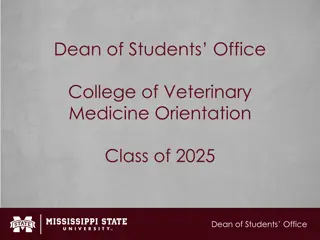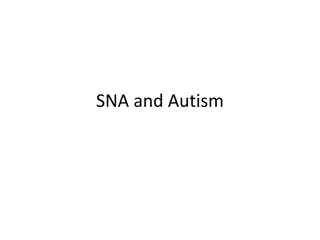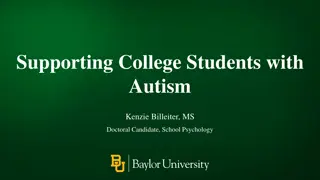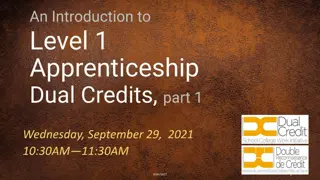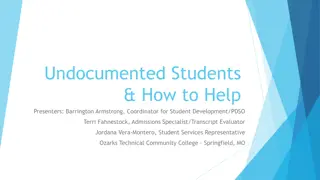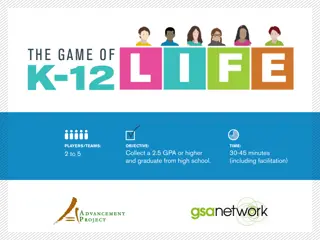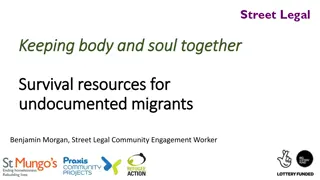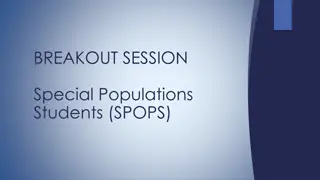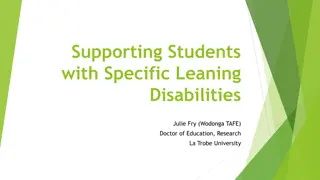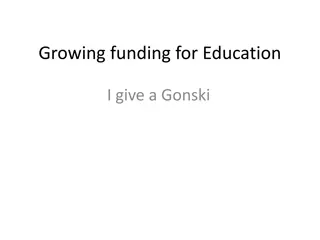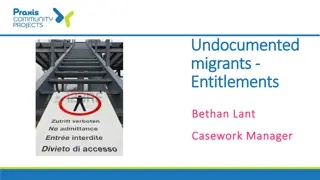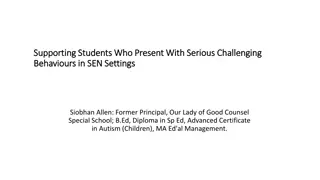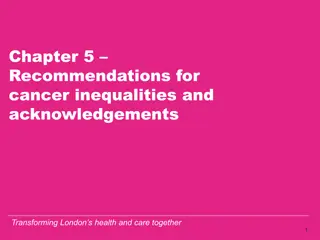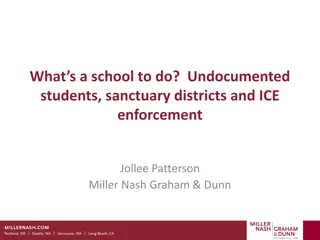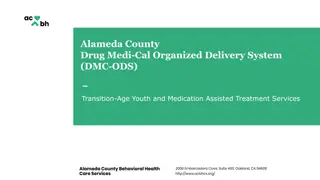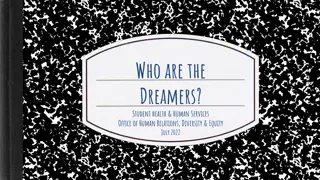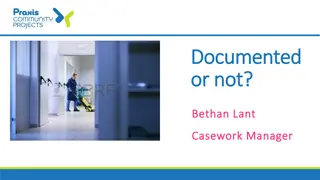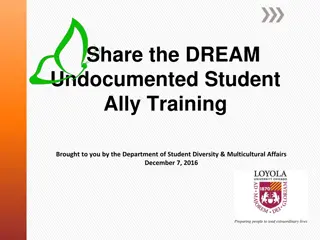Understanding and Supporting Undocumented Students in Education
This webinar covers the history, legality, and challenges faced by undocumented students in the United States. It delves into admissions, financial aid, DACA, advocacy, and developing policies to support these students in higher education. Despite terminology debates, the focus is on maximizing services within current laws and being advocates for educational opportunities. Facts and myths about undocumented students are addressed to provide clarity and guidance for educators.
Download Presentation

Please find below an Image/Link to download the presentation.
The content on the website is provided AS IS for your information and personal use only. It may not be sold, licensed, or shared on other websites without obtaining consent from the author. Download presentation by click this link. If you encounter any issues during the download, it is possible that the publisher has removed the file from their server.
E N D
Presentation Transcript
Serving Undocumented Students Webinar
Welcome Introductions House-keeping items About TTC
Todays Agenda History and legality of the issue A look at the past and current actions taken by states A note on admissions and financial aid DACA BREAKING NEWS Formulation of a plan to serve these students Beyond higher education Question and answer session
What is our purpose We need to discuss the background of this issue to move forward We need to develop admissions and advising policies that serve these students We need to be advocates for these students as higher education professionals
Illegal Aliens? Debate over use of this term continues to be a controversial issue Term Alien means any person not a citizen or national of the US Illegal Alien is any alien whose most recent entry was without inspection or whose initial valid status has expired US Code, Title 8 Undocumented Students vs. Students out of Status (Visa Overstays)
Forget the verbiage Despite terminology, our mission as educators should be our concern Maximizing the service we provide within current law should be our focus Understanding that the issue is ongoing and ever changing
Facts Approximately 65,000 Undocumented Students are graduating from U.S. High Schools each year Estimation is that only 5-10% of these students pursue post-secondary education Many may not even realize the barriers that they will face when pursuing postsecondary education The future is relatively unclear as to how the United States will approach their status
The Biggest Myth In NO FEDERAL law or policy does it state that it is unlawful to admit and allow to study an undocumented immigrant. Notice the emphasis on FEDERAL We are not ICE agents We cannot be held at fault for advising these students on their potential pathway
The Second Biggest Myth Federal law does not prohibit states from offering in-state tuition Section 505 of the Illegal Immigrant Reform and Immigrant Reconciliation Act of 1996 (IIRIRA) prohibits states from providing any higher education benefit based on residency to undocumented immigrants unless they provide the same benefit to U.S. citizens in the same circumstances, regardless of their residence.
Clarification States who offer in-state tuition require a certain amount of time in-state at secondary education institutions to qualify for residency. Since they can apply this same requirement to a U.S. citizen in order to establish state residency, then an undocumented student may do this as well.
The Misconception The thought has been out there that state specific legislation was overruling federal law. The way that the federal law was written was intentionally vague to give states the authority to handle this issue themselves. This put more spotlight on the state regarding this issue and less on the federal government. The thought of an all encompassing piece of federal regulation has been on the table for years
An Example of Change The next slides portray a small part of the story Change or proposed changes are occurring nearly daily across the states Keeping up with these changes will allow us to maximize our service within the law
Admission of Students Banned enrollments at public higher education institutions Alabama Georgia South Carolina
Admission of Students Admission of students at Private Institutions is permissible nationwide Admission at all Public Institutions nationwide is permissible aside from the previous exceptions Some have made institutional decisions to ban enrollment of undocumented students Many who choose to do this have, or will have, potential scrutiny from immigration law organizations and student groups
Admission of Students Access and community education are key Know your demographics Formulate an application that promotes inclusion The most common addition to the application is a status option called Not a citizen, permanent resident, or active status non-immigrant Although you could use undocumented as a status option, most do not. Undocumented students should not be classified as international
Financial Aid Undocumented students cannot legally receive any federally funded student financial aid, including loans, grants, scholarships, and work-study programs. DACA students may use their SSN to fill out the FAFSA in order to receive a student aid report. Many states are pushing through miniature DREAM acts to provide potential state aid, in-state tuition, employment benefits This opens up more options for scholarships and institutional aid
Financial Aid An example of a few states such as California, Washington, New Mexico, Texas, and Oklahoma have their own way of determining financial need and may not require a FAFSA This list continues to grow as more legislation is pushed through Undocumented students who are not under DACA cannot fill out the FAFSA, but may be able to complete some state s internal financial need calculators.
Scholarships and other aid Multiple organizations throughout the US are providing increasing funding options for undocumented students For lack of a better term an explosion of aid has occurred in the last 3 years Non-profit organizations, private school dollars, community access organizations are just a few Legislation in many states are opening up grants, loans, and scholarships to anyone regardless of status
DACA and DAPA DACA deferred action for childhood arrivals been in place since June 2012 Future Unclear DAPA - deferred action for parents of Americans and lawful permanent residents program was just denied due to a split in the supreme court. This decision keeps DACA the same and DAPA is off the table for now.
DACA Provides a lawful, but temporary, status in the US executive order may be in jeopardy Expansion of program was denied Benefits may include (based on state s policy) Establishing in-state residency Work permits is currently a 2 year permit-may change Driver s license Professional licenses Health care www.phdreamers.org
Advance Parole Travel request for those on unexpired DACA Very risky at this point May provide a legal reentry to the US https://www.ilrc.org/sites/default/files/resourc es/prac_adv-daca_advance_parole_fam_pet- 20160531.pdf Limited reasons for travel include: Humanitarian reasons Educational reasons Employment
Advance Parole Students must fill out the I-131 form Supply DACA approval notice Include evidence that their trip fits within the guidelines Pay $725 application fee Recognize that this can be risky for students, as return to the US is no guarantee. Some have been granted a change of status upon return
What is our duty? As higher education institutions, we should be advocates for any students success. We should promote admission of these students into our institutions as federal law does not take ability from us that. Despite our opinions on immigration law within the U.S., we are, at our core, educators.
Where to start? The process of enhancing your services begins with community education on the topic The complexity of this subject is not always the easiest to keep up with Again, knowing your community demographics is crucial to making institutional decisions to move forward with a plan
How do we serve these students? Safe space is crucial Providing blanket knowledge to our community about the benefits available to undocumented students is the start Families are crucial in the beginning phase and throughout Abide by FERPA Undocumented students are protected under FERPA just as our other students
Programming Community Involvement Understand your communities and engage Off site informational sessions to funnel to campus High School engagement Partner with school counselors to promote informational family sessions Initial contact may not be direct recruitment The college and financial planning session is a good start Bilingual Brochures for parents
Programming Start small and let the word get out Assess your pilot programs and implement needed change Hard recruitment is well hard Utilize your off campus programming to promote visits to campus Involve student organizations in on and off campus recruitment Building trust by knowing your facts
Retention Not unlike any other student engagement with campus is key to retention Train your team Students affairs, faculty, athletics, advisors, career services etc all should be educated on the ins and outs of working with undocumented students Training sessions
After Higher Ed As with any student we should begin the discussion of what happens after graduation early in the process Know the career options for undocumented students Research the ability to work within a field Professional license SSN requirements Future outlook
Summary Be diligent This issue changes constantly Be aware of the actions taken in your state and an eye on changes in the federal programs DACA and DAPA Watch for negative legislation at the state level and be a proponent of positive change
Open for questions I will answer as many questions from the chat board that I can Contact me with any assistance you may need Chad Teman chad@temantraining.com 419-230-4798
Resources The College Board MALDEF United States CFR NILC- https://www.nilc.org/wp- content/uploads/2015/11/state-education-bills- 2016.pdf USCIS




